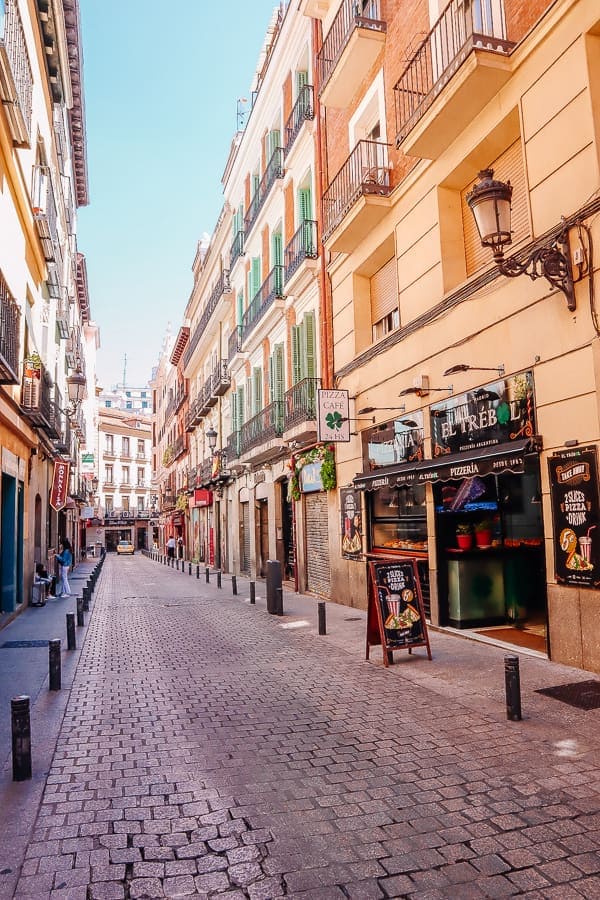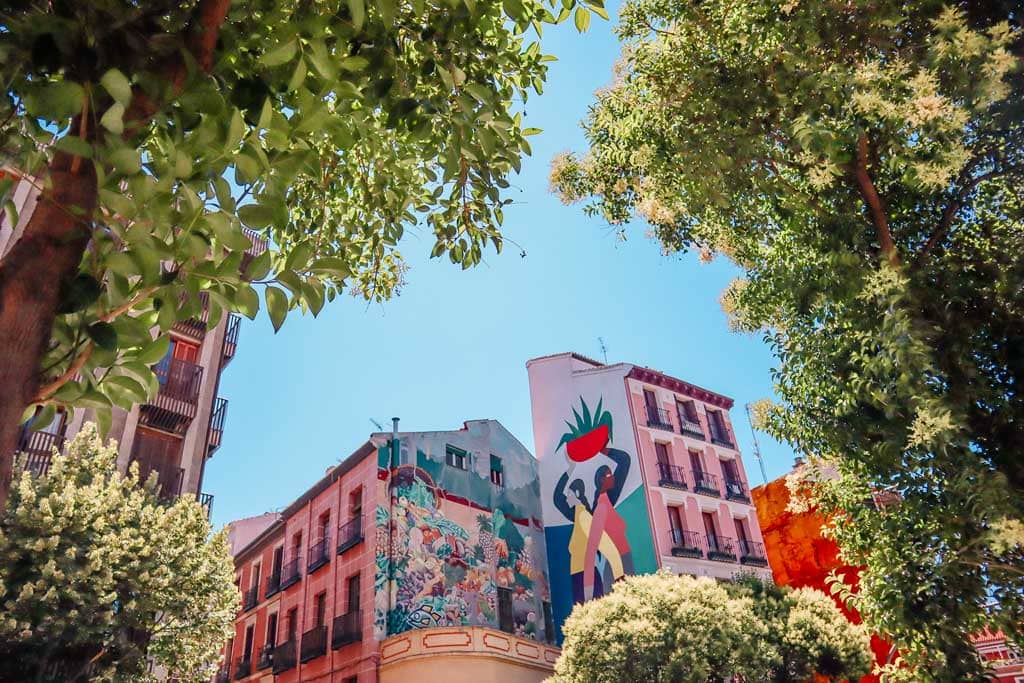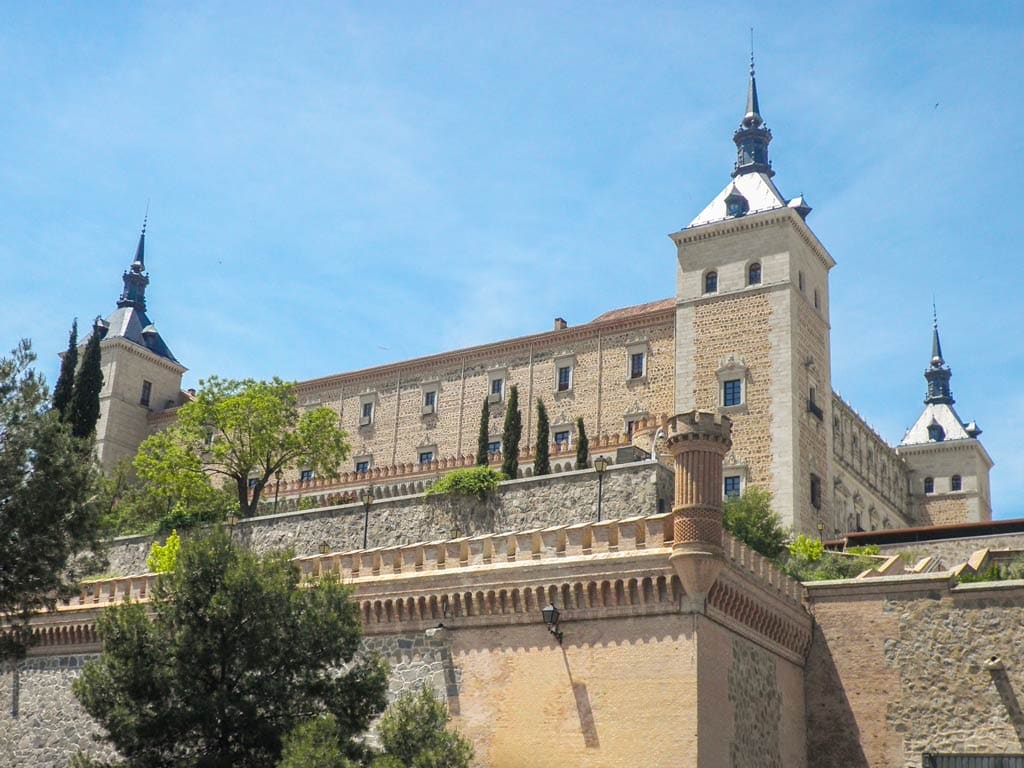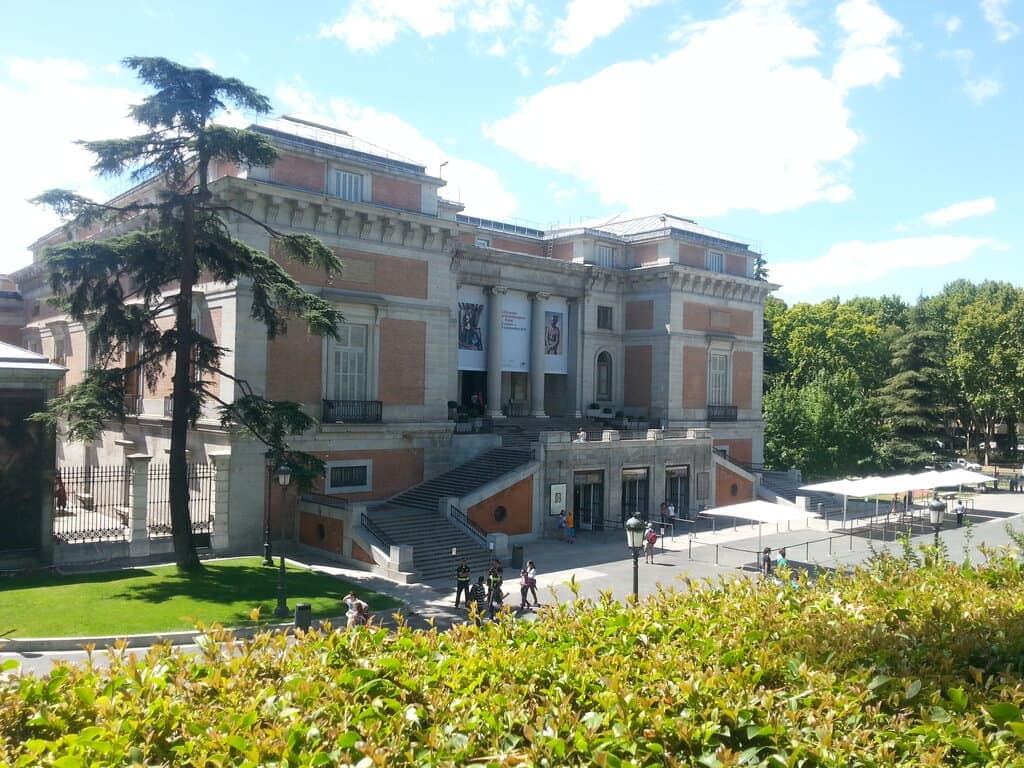If you’re a first-time visitor to Spain‘s capital, you’re in for a treat. I’m pretty sure that 4 days in Madrid will leave you wanting more, as it is the kind of city that has something to offer every type of traveler, and there’s always something more to do or see.
From must-see landmarks to visit-worthy museums to amazing places to eat, here’s a Madrid itinerary that will make you fall in love with my favorite city.
*This post may contain affiliate links from which I earn a commission (for more info, read my disclosure). As an Amazon Associate, I earn from qualifying purchases.
*I try to keep the information on this blog as updated as possible, but I still recommend consulting the latest prices, opening hours, and other details on the official website of each site, hotel, and tour, as well as checking the updated public transport routes and timetables.

4-Day Madrid Itinerary Summary
Here’s a quick summary to give you an idea of what you’re going to see and do:
Day 1: Royal Palace and surroundings, San Miguel Market, Chocolatería San Ginés, Plaza Mayor, La Latina neighborhood.
Since daily visits are limited, be sure to purchase your ticket to the Royal Palace and pick a specific timeslot in advance or book a guided tour.
Day 2: Day trip to Segovia/Toledo/other.
If you don’t want to take a day trip independently by train, book a guided day tour of Segovia and Toledo, two remarkable UNESCO-listed historic cities.
Day 3: Puerta del Sol, Barrio de las Letras, Golden Triangle of Art (Prado Museum/Reina Sofia Museum/Thyssen-Bornemisza Museum – purchase individual tickets here or get a combined ticket), Retiro Park.
Day 4: Gran Via, Malasaña neighborhood, one of several museum options, Oeste Park, sunset at the Debod Temple.
Other Activities to Add to Your Madrid Travel Itinerary
Here are a few highly-rated day tours you can book (day 2 is dedicated to a day trip):
- Segovia and Toledo, unmissable UNESCO-listed cities
- Hot Air Balloon flight over Segovia (with transfers)
- Alcala de Henares, Miguel de Cervantes’ birthplace
- Royal Site of El Escorial, the largest Renaissance building in the world
- Cuenca and the Enchanted City, an intriguing historic city and a unique natural landmark
- Guadarrama National Park day trip, including the Manzanares el Real Castle
Here are a few highly-rated activities you can add to this Madrid itinerary:
- Four different FREE walking tours of Madrid
- Wine and tapas food tour
- Flamenco show (with optional food and drinks)
- A tour of Real Madrid’s Santiago Bernabéu Stadium
- If you’re in Madrid on a Sunday, don’t miss the El Rastro market

Where to Stay in Madrid
The city center is big, but it consists of quite a few relatively small neighborhoods, so there are more than enough central areas to stay in Madrid.
Many people choose Sol-Gran Via because it’s the heart of the center, but the vibrant Malasaña, the enchanting Barrio de las Letras, and Los Austrias (the oldest district) are also ideal (you’ll visit all of them if you use this itinerary).
If you’re looking for a hostel, check out The Hat or Mola Hostel.
If you’re a mid-range traveler like me, check out Woohoo Rooms Boutique Sol, Apartosuites Jardines de Sabatini, or Hostal Royal Cruz.
For something more upscale, the highly-rated Oriente Palace Apartments, CoolRooms Atocha, or 7 Islas Hotel might be the right choice for you.

Are 4 Days in Madrid Enough? How Many Days to Spend in Madrid?
As someone who is completely in love with Madrid, my short answer is no, four days are not enough to experience everything Madrid has to offer.
With the number of parks, museums, markets, tours, cafes, tapas bars, and other activities you can find in Madrid, no amount of time is ever “enough.”
Yet, most of us can’t plan never-ending trips, so you’ll be happy to know that in four days in Madrid, you can definitely see many of the city’s highlights, as well as some of its hidden gems. If you have time and want to embrace Slow Travel, add at least 2-3 more days.
4 Days in Madrid – Day 1
Breakfast – Santa Eulalia
There’s no shortage of places to have breakfast in Madrid, but Santa Eulalia is a wonderful spot to kick off this Madrid 4-day itinerary.
Hidden in a quiet street less than a 5-minute walk away from the Royal Palace, this cozy cafe-patisserie serves the most amazing pastries, as well as specialty coffee, sandwiches, toast, eggs, and more.
Royal Palace (And Surroundings)
The things that will make you fall in love with Madrid are the atmosphere, the lively streets, and the people. But that doesn’t mean you should skip out on the city’s landmarks, and the Royal Palace (Palacio Real) is the first one you should visit.
The 18th-century Baroque building is the official residence of the Spanish royal family (though it’s currently only used for ceremonies) and Europe’s largest functioning palace.
Your visit will include the Throne Room, the stunning Salón de Gasparini, the impressive Royal Armory, and other rooms, many of which are decorated with colorful frescoes, centuries-old furniture, and paintings by artists like Caravaggio, Goya, and Velázquez.
Fun fact about Madrid‘s Royal Palace: It houses the only complete Stradivarius string quintet in the world!
Since daily visits are limited and you need to pick a specific timeslot, be sure to purchase your ticket to the Royal Palace in advance or book a guided tour.
Next to the palace, you’ll find the beautiful Plaza de Oriente, the Sabatini Gardens, the Almudena Cathedral, and the Campo del Moro Gardens, which are also worth exploring.

Lunch – San Miguel Market
There’s a good chance it’s already lunchtime, which means you can head to the infamous 100-year-old San Miguel Market (Mercado de San Miguel).
The stylish indoor food market offers more than enough culinary options, from patatas bravas to seafood to croquettes. Grab a bite, savor a caña (a small glass of beer), and prepare to devour a delicious sweet treat.
Chocolateria San Gines
As an avid carb lover, churros are one of the first things I eat when I’m visiting Madrid. Sometimes mistaken for a dessert, these little pieces of heaven are usually eaten by locals for breakfast or an afternoon snack.
Luckily, the famous 19th-century Chocolateria San Gines is open every day from 8 AM to 11:30 PM (though it used to work 24/7), so you can come here right after lunch.
Now, since this place has become so famous and popular, some might say that it’s overrated, but I personally can’t get enough of its hot, crispy churros dipped into decadent yet not-too-sweet hot chocolate.
Tip: At the corner of the alley, you’ll find the San Ginés Book Shop, one of the cutest spots in Madrid.

Plaza Mayor
Commissioned by King Felipe II, the 17th-century Plaza Mayor is a gorgeous historic European square you can’t miss.
Here you can enjoy people-watching, admire a statue of King Felipe III, and see the photogenic Casa de la Panadería, decorated with paintings of mythological figures from Madrid’s history.
Step outside the square through the Arco de Cuchilleros (Knifemen’s Arch) and walk down the beautiful Cuchilleros street, which is lined with cafes and restaurants, including Sobrino de Botín, the oldest restaurant in the world according to Guinness World Records (founded in 1725).

La Latina
At the end of Cuchilleros Street, you’ll find the lovely Plaza de la Puerta Cerrada, from which you can start exploring the neighborhood of La Latina, one of the best neighborhoods to eat tapas in Madrid and known for its old-town vibe.
Stroll through the narrow streets, visit the Saint Isidore Museum (showcasing the city’s history from prehistoric times), check out the Cebada Market, admire the Toledo Gate, and unwind at the Garden of the Prince of Anglona.

Dinner at la Latina
The first day is coming to an end, and you’ll probably be hungry again by now.
Luckily, in this area, there are more than enough incredible places to eat delicious tapas with a glass of wine, including Juana La Loca, La Perejila (located on the famous Cava Baja Street), and Casa Gerardo.
4 Days in Madrid – Day 2
You can certainly spend all four days in Madrid, but I recommend taking one day trip.
You’ll find plenty of gorgeous places to visit near the Spanish capital, and if you’re a first-time visitor, either Toledo or Segovia will be a perfect choice as they’re both must-see UNESCO-listed cities.
You can also book a combined guided day tour to Segovia & Toledo.
Segovia
Segovia is a UNESCO city known for three significant landmarks – its cathedral, Alcazar, and Roman aqueduct, but there’s a lot more to see here.
Getting to Segovia
A half-an-hour train ride will take you from Madrid’s Chamartin station to Segovia. From there, take bus number 11 or 12 to the city center.
You can (and should) book your train tickets from Madrid to Segovia in advance on Omio (formerly GoEuro – which compares train and bus prices).
You can also take a guided day trip to Segovia & Avila or book a combined day tour to Toledo & Segovia.

Top Things to Do in Segovia
Aqueduct of Segovia: This landmark is an architectural masterpiece and one of the world’s best-preserved elevated Roman aqueducts.
Alcázar of Segovia: One of the inspirations for Disney’s castles, the fairytale-like royal palace/fortress is one of the most striking Spanish landmarks. It was first documented in the 12th century, though it may have existed a lot earlier.
Segovia Cathedral: Known as ‘The Lady of the Cathedrals,’ it is the last Gothic cathedral built in Spain (in the 16th century when Europe had already embraced the Renaissance style). To learn more about it, you can take this walking tour that includes the entrance to the Alcazar and Cathedral.
You should also walk along the medieval walls, stroll through the Jewish Quarter, visit the city’s incredible viewpoints, indulge in regional food, and, if you have some spare time – visit the nearby Royal Palace of La Granja de San Ildefonso.

Toledo
Toledo is a magnificent UNESCO city with Jewish, Christian, and Moorish history. Along with marveling at countless of its centuries-old landmarks, you can also enjoy scenic viewpoints, enchanting alleys, and more.
Getting to Toledo
You can easily get to Toledo by bus or train from Madrid. I love using Spain’s convenient train system, Renfe, which will take you from Madrid’s Atocha station to Toledo in about half an hour. From there, take bus number L61/L62/L511 to the city center.
You must book your train tickets from Madrid to Toledo in advance, which you can do on Omio (formerly GoEuro), a site that compares train and bus (and flight) prices in one place.
You can also take a guided day tour to Toledo or book a combined trip to Segovia & Toledo.

Top Things to Do in Toledo
There’s only so much you can see in one day in Toledo, but some places are unmissable.
Alcázar de Toledo: Originally a Roman palace, it was rebuilt several times in the 11th-16th centuries under the Spanish kings and functioned as a fortress. Today, it houses the national Army Museum.
Toledo Cathedral: Built in the 13th century, this impressive cathedral is one of the finest examples of Gothic architecture in Spain. You can tour it with a local guide.
Synagogues: To learn more about the thriving Jewish community that once lived in Toledo, visit the 12th-century Synagogue of Santa María la Blanca (turned into a church) and the 14th-century Synagogue of El Tránsito.
El Greco Museum: The famous painter (who was born in Crete in the 16th century) loved Toledo and lived there until his death. The museum dedicated to him houses some of his artworks as well as 17th-century pieces created by Spanish painters.
You should also see Toledo’s remaining city gates (like Puerta de Bisagra) and bridges (Alcantara and San Martin), try some of Toledo’s famous marzipan, and take the perfect postcard photo from the Mirador del Valle. Optional – take a free walking tour of Toledo.

Other Easy Day Trips From Madrid
Whether you’re looking for famous or underrated places, you’ll find dozens of options for day trips from Madrid.
From the Atocha train station, you can take the C2 or C7 train line to Alcala de Henares (both leave frequently, and there’s no need to book your ticket in advance), the birthplace of Miguel de Cervantes, the infamous author of Don Quixote.
Read about the things you can do in Alcala de Henares or book this half-a-day tour.
The C3 train line will take you from Atocha station (or even from Sol) to Aranjuez, home to the Royal Palace of Aranjuez and its stunning gardens, dating back to the 16th-18th centuries.
The C3a line will get you to El Escorial, where you’ll find the Royal Site of San Lorenzo de El Escorial, the largest Renaissance building in the world, housing a royal monastery, a palace, and more. Explore it with this free walking tour or book a half a day tour.
If that’s not enough, check out these highly-rated day tours:
- Avila and Salamanca
- Cuenca and the Enchanted City
- Guadarrama National Park day trip (including the Manzanares el Real Castle)

4 Days in Madrid – Day 3
Breakfast – La Mallorquina
If coffee and pastries are your kind breakfast, you’ll love La Mallorquina, one of the most famous bakeries in Madrid. Established in the late 19th century, it was a gathering place where people would discuss art, politics, and other issues.
It’s a wonderful place to have a cafe con leche and a sweet or savory freshly baked good like a croissant, an ensaimada (a traditional pastry from Mallorca), or a napolitana (one of the most popular choices).

Puerta Del SOL
Puerta del Sol is the busiest square in Madrid and the heart of the city center. Countless shops and restaurants line the surrounding streets, so the area is always full of life.
Here you’ll find the statue of Carlos III of Spain and the famous sculpture of El Oso y El Madroño (The Bear and the Strawberry Tree), the symbol of Madrid’s coat of arms.
A bit trickier to locate, the plaque of Kilometro Cero is also found here. Considered the geographical center of Spain, it marks the starting point from which the distances of the national roads are measured.
Barrio de Las Letras
Also known as Madrid’s Literary Quarter, Barrio de las Letras is, without a doubt, my favorite neighborhood in Madrid.
It boasts a unique type of charm that I can’t even put into words, but maybe it has something to do with the fact that many Spanish cultural icons had chosen it as their home, from Miguel de Cervantes (the author of Don Quixote) to Lope de Vega to Federico García Lorca.
Here you’ll find old theatres, beautiful urban art, the houses of Cervantes and Lope de Vega, lively streets and squares (like Calle de las Huertas and Plaza de Santa Ana), tapas bars, and literary quotes imprinted on the ground.
You can explore its magical corners on your own or take a free walking tour. The neighborhood’s history is absolutely fascinating, and hearing it from a local guide will only make your visit more special.
Extra tip: Grab a cup of specialty coffee at FELIZ COFFEE.

Lunch – Casa Alberto
On Calle de las Huertas, you’ll find Casa Alberto, established in 1827. It’s going to be busy, but that’s how you know it’s a locals’ favorite.
You can stand by the bar and order tapas and appetizers like Spanish omelet (tortilla de patatas/tortilla española), Manchego cheese, and croquettes. If you’re craving a heavier meal, ask to sit at a table.
Golden Triangle of Art
You don’t have to be an art fanatic to appreciate the significance of the Golden Triangle of Art – the Prado Museum, Reina Sofía Museum (Museo Nacional Centro de Arte Reina Sofía), and Thyssen-Bornemisza Museum.
Together, these three world-class art museums boast one of the finest collections of Spanish art from the 12th-20th centuries (along with pieces by Italian, Flemish, and other European artists).
The Golden Triangle of Art houses works by Picasso, Goya, El Greco, Dalí, and other famous painters. To make the most of your 4-day Madrid itinerary, choose which one of the museums to visit as they are huge, and you’ll need an entire day to explore all three.
Also, plan your visit in advance and decide which sections to see in each museum (2 hours in the Prado Museum were only enough to see about 5% of its collection).
Buy your Prado, Reina Sofía, and Thyssen-Bornemisza tickets here, or opt for a combo ticket that is valid for one year.
If you don’t want to visit any of the three museums, head instead to the Real Jardín Botánico (Royal Botanical Garden), located right between the Prado Museum and Retiro Park (our next stop).

Retiro Park
A stone’s throw away from the museums, you’ll find the lively Retiro Park (also called El Retiro or Parque del Buen Retiro), an unmissable landmark in Madrid and a UNESCO World Heritage Site.
Its history traces back all the way to the 16th century, and after about 300 years of belonging to the Spanish monarchs, it opened to the public in the late 19th century.
Probably the most popular park in Madrid (and there are a lot of them), El Retiro is packed with unique monuments and beautiful corners, from the photogenic Crystal Palace and the Monument to Alfonso XII of Spain, (which overlooks the park’s lake) to the Velazquez Palace and the Rose Garden.
This is an ideal spot for a relaxing afternoon stroll, and you can also explore the park with a guided segway tour.

Dinner – Casa Toni
Step outside the park via its northern gate to get to Alcala Street. You’ll immediately see Puerta de Alcala, the first Arc de Triomphe built in Europe after the fall of the Roman Empire and one of Madrid’s old city gates.
Walk to the west, and you’ll come across the stunning Plaza de Cibeles. Continue to Calle de Sevilla and Calle de la Cruz to get to Casa Toni, another great tapas bar in Madrid.
Its outer facade might not be the most impressive or inviting, but trust me, the food will win you over (don’t skip out on the grilled mushrooms!).
4 Days in Madrid – Day 4
Breakfast – Brunch Club Cafe
Start your last day at the Brunch Club Cafe, one of the best all-day brunch places in Madrid. Enjoy their fixed-price full brunch, or check out their diverse weekday menu – you won’t be disappointed.
Gran Via
It’s technically impossible to visit Madrid and not walk on one of its most famous avenues, the Gran Via, lined with big beautiful buildings (including the Metropolis Building and Telefónica Building), shops, restaurants, and hotels.
Opt for some shopping time or just stroll along the bustling avenue.
Malasaña
A bit bohemian and a bit hipster, Malasaña is the perfect neighborhood for those who love concept shops, art galleries, trendy cafes & bars, and colorful streets.
Head to Plaza del Dos de Mayo, Calle del Pez, Calle del Espiritu Santo, or explore it freely on your own.

Before or After Lunch – Visit a Museum
Depending on whether or not you took some time for shopping, visit one of these Madrid museums before or after lunch:
Museum of Romanticism: Technically located in the Chueca neighborhood but close to Malasaña, this 19th-century-style house museum showcases the everyday life in Madrid during the artistic period of Romanticism.
History Museum of Madrid: Housed in a beautiful pink Baroque building, in this museum you’ll learn about Madrid’s history between the 16th and 20th centuries. The entrance is free!
Liria Palace: This luxurious palace was the official Madrid residence of an aristocratic Spanish family, the House of Alba, dating back to the 18th century. Get your ticket here.
Lunch
There’s no shortage of great places to eat in the area, so check out Casa Macareno, Bodega de la Ardosa, or Pez Tortilla (specializing in Spanish omelets).

Oeste Park and Debod Temple
Head to the lovely Oeste Park, and don’t miss its rose garden (Rosaleda del Parque del Oeste) – if you’re visiting in spring, you’re in for a treat!
Continue to the Debod Temple, which makes for a perfect sunset spot. Curiously, it is a real Egyptian temple from the 2nd century BC that was gifted to Spain by Egypt.
Be sure to enjoy the views at the nearby Mirador de la Montaña de Príncipe Pío, overlooking the Royal Palace. You can also head to the magnificent Plaza de España, which should be illuminated by now.

Dinner
You can finish off your last day in Madrid at the uniquely-decored restaurant – El Invernadero de Salvador Bachiller (Gran Via, 65).
Salvador Bachiller is a Spanish brand with beautiful stores that sell luggage, home decor, perfumes, and more.
But the SB group also has several cafes and restaurants in Madrid, including El Invernadero (The Greenhouse), which literally looks like a greenhouse and is housed in one of the stores.

Visiting Madrid in 4 Days: Other Tips and Notes
When to Visit Madrid
Late spring and early fall offer the best weather, though Madrid is also an amazing winter city break in Europe.
Getting From the Airport and Getting Around Madrid
One of the easiest ways to get from the airport to the city center is by metro, but here you’ll find more options.
You can also use Madrid’s extensive metro system (one of the best in Europe) to get around, but this itinerary is pretty much walkable, so bring comfortable sneakers.
OTHER MADRID & SPAIN TRAVEL GUIDES
Read more to make the most of Madrid in four days:
- Hidden gems in Madrid
- Where to stay in Madrid
- Madrid travel tips
- What to pack for Madrid
- Best walking tours in Madrid
- 2 days in Madrid
- Is Madrid worth visiting?
Was my Madrid trip itinerary helpful? Read more about Spain:
- Spain travel tips
- Long weekend breaks in Spain
- Hidden gems of Spain
- Best Spanish road trips
- Novels set in Spain
- Spain-themed gifts
- Spain travel quotes
- Virtual tours of Spain
Related posts:


I absolutely loved your suggestions. We are two couples in our early 60s; some going for the first time to Madrid, and others second or third; but, many many years ago, and or just brief passing through. Any additional suggestions will be greatly appreciated. Enjoy your travels. Love Mariana.
PS hard to imagine that there is a greater carb addict than myself!
Always a pleasure to meet a fellow carb lover!
Feel free to check out my other Madrid posts – there’s a lot of info on cafes, landmarks, hidden gems, and plenty of other tips 🙂